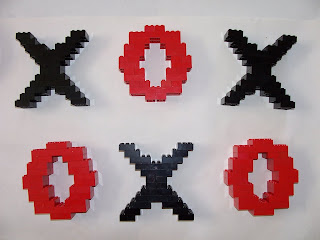The cubby is a 3x3 array of squares. Every single time I pass it I think of tic-tac-toe. Surely I can't be the only one that thinks of this, so I thought it would be funny to put Xs and Os in there for everyone else to enjoy. But how to make them? Eventually my officemate thought of Lego. Of course!
We actually went through a few designs that were rejected because of strength issues or ugliness or size. Finally I hit on a pretty strong design for both pieces that, if I do say so myself, looks very nice.

Unfortunately, cameras are even less allowed than cellphones, so I can't take a picture in situ. However, I'm posting this a while after putting it up, so here's a sample of coworker reactions:
- nothing
- small, confused smile
- swapping of X for O to change outcome of illustrated game (happened many times)
- "Niiiiiice" (in a Korean cleaning lady accent)
- "Are you the LegoMeister? Nicely done."
- From my boss's boss: something whispered about tic tac toe I guess he was trying to keep my identity secret?
- I've noticed many games in progress, with one move played by each passer-by. Also, I've heard reports of some people just standing in front of the cubbies to play a whole game.





